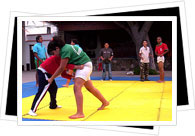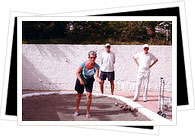In addition to the typical competition sports like football and basketball that mainland Spain enjoys, the Canary Islands take the sports scene up yet another notch. You can find Canary Islanders cheering and partaking in a wide range of traditional sports, most of which were structured and developed by the islands' ancient indigenous culture: the Guanches.
These sports and games, which are now considered to be a traditional facet of the islands' culture, are rooted in the traditional training and practice of self-defense tactics that have been passed down from generation to generation. These traditional Canary Island sports have enjoyed a revolutionizing revival of popularity and support, both from the islands' government and the islanders themselves. Helping to conserve these sports are the Tenerife government, which has included them in a major initiative called "Tenerife and Our Way of Life," as well as a wealth of native sports training schools scattered throughout the islands.
If you're in Tenerife in late April or early May, check to see if your trip coincides with the Torneo de Envite (Challenge Tournament). Held in the town of Tegueste - not far from the capital city of Santa Cruz - during the town's Romería de San Marcos festival, it's essentially an annual showcase of the Canary Islands' traditional competitive and rural sports- lucha canaria, bola canaria, oxen pulls, handball and more.
Lucha Canaria / Canarian Wrestling
 If you're up for some full-fledged grappling, the sport known as "lucha
canaria" is one of the most popular sports in the Canary Islands. Practically
every borough has its own traditional dirt "terrero," or wrestling
ring, where teams of wrestlers compete year-round.
If you're up for some full-fledged grappling, the sport known as "lucha
canaria" is one of the most popular sports in the Canary Islands. Practically
every borough has its own traditional dirt "terrero," or wrestling
ring, where teams of wrestlers compete year-round.
These wrestling matches are performed barefoot, each wrestler using various "mañas" (techniques) in an attempt to unbalance his opponent. While doing this, the goal is to stay on your feet, because if any part of your body other than your bare feet touches the ground, you lose the "agarrada" (round).
The competitor who wins the best of three such rounds is declared the winner, and the team with the most wins is the champion of the "brega." Just like modern-day competitive sports, a "brega" (bout) is the matchup between two 12-member teams. The teams are even led by coaches who decide which fighters will go up against the competition, and a referee-type official makes the calls and declares the winners.
Early adventurers who made stops on the islands prior to the Spanish conquest scrawled various accounts of these wrestling matches between the Guanches, who traditionally used these matches to settle land and livestock disputes.
Juego del Palo / Staff Fighting
The "juego del palo" is essentially the Canarian take on fencing-
minus the snazzy white outfits and aristocratic undertones. Having developed
and evolved in the Guanche culture as a self-defense
training activity, this traditional Canary Island sport has centuries of history
under its belt and shows no sign of disappearing any time soon. Often passed
down from generation to generation within families, there are also training
centers dispersed throughout the island which promote the conservation of the
sport.
The game, which is more like a friendly confrontation, has a fairly simple structure. Two staff-wielding contestants engage in the sport, each trying to out-strategize his opponent. The "mandado" (attacker) aims to touch the "atajiado" (defender) on uncovered parts of his body, but without full contact and never intending to cause injury. Naturally, the role of the atajiado is to therefore defend himself. Depending on the region, the island and the type of game being played, this staff can be long or short- short-sticked juego de palo is considered to be the trickiest.
Salto del Pastor / Shepherd's Leap
If you come across a Salto del Pastor contest, you're not
likely to forget it! Using long poles, men essentially pole-vault their way
down steep mountain sides at speeds that appear to be borderline out of control.
An obviously exciting adrenalin rush for its participants, as a Salto del Palo
spectator you can't help but hold your breath as you watch these skilled jumpers
fly - quite literally - down hill sides.
In what basically boils down to the hybrid of pole-vaulting, mountain-climbing and a high-intensity running race, many wonder just how this peculiar sport got its start. Like the majority of traditional Canary Island sports, the Salto del Pastor is a lasting vestige of the archipelago's Guanche past. However, unlike Lucha Canaria and Juego del Palo, it was never a training exercise.
In its origin, the pole was actually a simple shepherd's staff used to guide the livestock to higher - or lower, depending on the season - pastures. Soon, the shepherds took to using their staff to move at quicker paces across pastures and down hills. Little by little, first with the indiginous natives and then through their descendents, what was a simple practicality became a tradition, and what was a tradition morphed into an all-out sport.
Bola Canaria / Canarian Boules
 Unlike the three aforementioned Canary Island sports, Bola Canaria
is not a Guanche-inspired game, although when
the game was introduced the Guanches, known for their exceptional stone-wielding
skills, excelled at it. Bola Canaria, which can be compared to petanque or even
bowling, was wnce played with stones and later with wooden balls; today's evolved
version employs resin balls.
Unlike the three aforementioned Canary Island sports, Bola Canaria
is not a Guanche-inspired game, although when
the game was introduced the Guanches, known for their exceptional stone-wielding
skills, excelled at it. Bola Canaria, which can be compared to petanque or even
bowling, was wnce played with stones and later with wooden balls; today's evolved
version employs resin balls.
While there are several possibilites and theories, its origins on the islands aren't exactly pinpointed. There are countries situated on both sides of the Atlantic Ocean that have similar games - Venezuela, France, Spain. What is clear, however, is that the islands' history as a stopping point of cross-seas journeys plays into the game's integration into the Canary Islands sport scene.